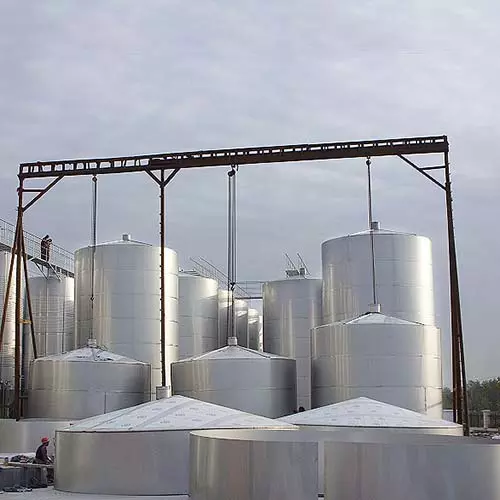A Guide to Stainless Steel Water Tank Technical Requirements (Part Two)

16. Stability in Design: Maintain a flat bottom plate to ensure stability in the water tank.
17. Precision Welding Standards: Fully weld the top and manhole of the water tank, adhering to the high-quality standards outlined in (8).
18. Meticulous Connection Ports: Ensure the well-welded connection port of the water tank is precisely aligned, aiming for verticality with a maximum inclination of 1°.
19. Stainless Steel Excellence: Select stainless steel plates meeting GB/T 3280 standards for the water tank, with a thickness tolerance within 10% for both inner and outer plates.
20. Safety Measures: Implement flanges or protective treatments for protruding parts inside and outside the water tank's inlet to prevent injuries.
21. Ventilation Assurance: Equip all water tanks with a vent pipe featuring a dust cover and a stainless steel insect-proof screen at the outer open end.
22. Structural Harmony: Ensure the water tank's strength and rigidity align with its capacity and water pressure requirements.
23. Premium Flange Integration: Incorporate stainless steel forging flanges into the water tank design for durability.
24. Certification Transparency: Manufacturers must provide detailed information about stainless steel plates, including manufacturing locations and qualified certificates.
25. Precision in Spherical Plate Formation: Extrude stainless steel spherical plates with a hydraulic press to prevent stress and hydrocarbon cracking.
26. Surface Integrity Standards: Maintain notches, scratches, and collision depth on the spherical plate surface below 0.3 mm.
27. Material Consistency in Connections: Externally connect the water tank with a short stainless steel tube, ensuring the flange material matches that of the water tank.
28. Vent Pipe Orientation Precision: Position the convex surface of the vent pipe's bottom plate facing downward with an opposite folding direction.
29. Post-Welding Excellence: After welding the stainless steel water tank, conduct pickling, passivation, and thorough residue removal.
30. Stringent Water-Tight Testing: Fill the fabricated water tank, following water-filled test clauses (GB50242-2013), ensuring no seepage, leakage, or deformation.
31. Water Quality Assurance Protocol: After cleaning, fill the water tank with water complying with GB5749 standards for 1h. Confirm that the outlet water meets GB5749 requirements.
17. Precision Welding Standards: Fully weld the top and manhole of the water tank, adhering to the high-quality standards outlined in (8).
18. Meticulous Connection Ports: Ensure the well-welded connection port of the water tank is precisely aligned, aiming for verticality with a maximum inclination of 1°.
19. Stainless Steel Excellence: Select stainless steel plates meeting GB/T 3280 standards for the water tank, with a thickness tolerance within 10% for both inner and outer plates.
20. Safety Measures: Implement flanges or protective treatments for protruding parts inside and outside the water tank's inlet to prevent injuries.
21. Ventilation Assurance: Equip all water tanks with a vent pipe featuring a dust cover and a stainless steel insect-proof screen at the outer open end.
22. Structural Harmony: Ensure the water tank's strength and rigidity align with its capacity and water pressure requirements.
23. Premium Flange Integration: Incorporate stainless steel forging flanges into the water tank design for durability.
24. Certification Transparency: Manufacturers must provide detailed information about stainless steel plates, including manufacturing locations and qualified certificates.
25. Precision in Spherical Plate Formation: Extrude stainless steel spherical plates with a hydraulic press to prevent stress and hydrocarbon cracking.
26. Surface Integrity Standards: Maintain notches, scratches, and collision depth on the spherical plate surface below 0.3 mm.
27. Material Consistency in Connections: Externally connect the water tank with a short stainless steel tube, ensuring the flange material matches that of the water tank.
28. Vent Pipe Orientation Precision: Position the convex surface of the vent pipe's bottom plate facing downward with an opposite folding direction.
29. Post-Welding Excellence: After welding the stainless steel water tank, conduct pickling, passivation, and thorough residue removal.
30. Stringent Water-Tight Testing: Fill the fabricated water tank, following water-filled test clauses (GB50242-2013), ensuring no seepage, leakage, or deformation.
31. Water Quality Assurance Protocol: After cleaning, fill the water tank with water complying with GB5749 standards for 1h. Confirm that the outlet water meets GB5749 requirements.
In essence, strict regulatory compliance is vital for stainless steel water tanks. Manufacturers must secure sanitary licenses, adhere to material and structural standards, and ensure quality in production. Key requirements include type and product inspection reports, along with meticulous adherence to design specifications. Precision in welding, material consistency, and post-welding processes is emphasized for a reliable and compliant water tank.

